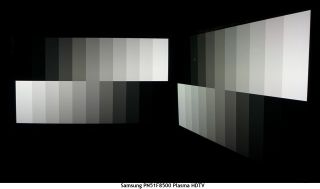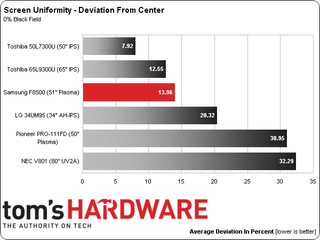Samsung PN51F8500 Review: A 51-Inch Plasma HDTV With SmartHub
Only two companies still make plasma TVs, so we’re excited to check out Samsung’s latest, the PN51F8500. It boasts 3D, SmartHub 2.0, and superb image quality. In the vast ocean of LCD televisions, it’s a compelling choice. Our lab results show you why.
Results: Viewing Angles and Uniformity
Besides greater contrast, plasma technology's other big advantage over LCD is superior off-axis image quality. If you plan to put more than three people in front of your HDTV, a plasma panel ensures that even those seated furthest from the sweet spot still see a great picture.

There is no visible difference between the head-on photo and the 45-degree one. Light output, detail levels, and color are unaffected when you sit off-center.
The top-down view is another matter entirely. Looking at the screen from a 45-degree angle above-center, the image is almost completely invisible. This behavior is not typical of other plasma displays. When we asked Samsung about it, representatives told us the F8500 has an additional polarizing layer added to help reject light reflected from the ceiling. Fortunately, side-to-side quality isn't affected, and at normal viewing distances the extra layer doesn't pose a problem. Just use common sense when you're installing the TV so the screen’s centerline is either at eye level or directed that way.
Screen Uniformity: Luminance
To measure screen uniformity, zero and 100-percent full-field patterns are used, and nine points are sampled. First, we establish a baseline measurement at the center of each screen. Then the surrounding eight points are measured. Their values get expressed as a percentage of the baseline, either above or below. This number is averaged.
It is important to remember that we only test the review sample each vendor sends us. Other examples of the same TV can measure differently.
First up is black field uniformity.

As size increases, manufacturing perfectly uniform screens becomes more difficult. LCD technology is at a disadvantage because its backlight is on the edges, requiring equalization with carefully placed diffusors. Plasma should fare better since its pixels emit their own light.
Stay on the Cutting Edge
Join the experts who read Tom's Hardware for the inside track on enthusiast PC tech news — and have for over 25 years. We'll send breaking news and in-depth reviews of CPUs, GPUs, AI, maker hardware and more straight to your inbox.
With that said, Toshiba should be proud that its 65-inch screen bests a 51-inch plasma in our test. Still, the F8500’s score of 13.96 percent isn’t too bad. Our measurements show slight hotspots in the upper-left and middle-right zones.
Here’s the white field measurement:

Plasma clearly wins in the white field test. Our reference Pioneer is still king. Samsung isn’t far behind. And we’re not surprised to see LG's computer monitor sneak into third place. NEC’s V801 finishes in a distant sixth place, mainly due to its 80-inch screen size. That’s a lot of area for an edge-backlight to cover.
Screen Uniformity: Color
To measure color uniformity, we display an 80-percent white field and measure the Delta E error of the same nine points on the screen. Then we simply subtract the lowest value from the highest to arrive at the result. A smaller number means a display is more uniform. Any value below three means a variation that is invisible to the naked eye.

Color uniformity is equally affected by screen size, so we wouldn't necessarily expect Samsung to run away with first place. Most 24- and 27-inch computer monitors measure under two Delta E. For the F8500 to demonstrate the same strong performance is a pleasant surprise.
Current page: Results: Viewing Angles and Uniformity
Prev Page Results: Color Gamut and Performance Next Page Results: Pixel Response and Input Lag
Christian Eberle is a Contributing Editor for Tom's Hardware US. He's a veteran reviewer of A/V equipment, specializing in monitors. Christian began his obsession with tech when he built his first PC in 1991, a 286 running DOS 3.0 at a blazing 12MHz. In 2006, he undertook training from the Imaging Science Foundation in video calibration and testing and thus started a passion for precise imaging that persists to this day. He is also a professional musician with a degree from the New England Conservatory as a classical bassoonist which he used to good effect as a performer with the West Point Army Band from 1987 to 2013. He enjoys watching movies and listening to high-end audio in his custom-built home theater and can be seen riding trails near his home on a race-ready ICE VTX recumbent trike. Christian enjoys the endless summer in Florida where he lives with his wife and Chihuahua and plays with orchestras around the state.
-
Nuckles_56 People still buy plasma screened TV's? I thought they went out like the floppy disk...Reply -
Merry_Blind Damn Samsung TVs have so much lag... They have amazing picture quality, but aren't fast enough for proper gaming... sigh... bring on the OLED!!!Reply -
n3cw4rr10r Am I the only one who thinks this is overpriced? especially with 4k TVs getting close to this range (Vizio P series will be out soon for $1000).Reply -
n3cw4rr10r Am I the only one who thinks this is overpriced? especially with 4k TVs getting close to this range (Vizio P series will be out soon for $1000).Reply -
colson79 It is such a shame everyone bailed on Plasma TV's, I still have one and the picture quality blows away LCD in the home theater. Hopefully my Plasma will last until OLED is reasonable. It would suck having to go to LCD.Reply -
jkhoward I love the quality of Plasma TV's.. I truly hope they keep developing this technology.Reply -
DisplayJunkie @Nuckles_56 your level of ignorance is astronomical yet not uncommon; you are making a fool of yourself.Reply
@n3cw4rr10r It's not overpriced at all, but rather an outstanding value (though not as good a value as the sorely-missed Panasonic P50ST60). The image quality is tremendously better than any 4K TV, even with perfect 4K source content, even if they sold the 4K TVs for $1500 or less. The difference in contrast(dynamic range) is the most important, and it is huge. Side-by-side with the plasma, no one would pick any 4K LCD. -
nthreem It's worth noting that Samsung announced it will discontinue production of plasmas at the end of the year. Better pick one up soon!Reply
I got a Panasonic VT60 at the beginning of the year, just as stock was running dry. I'm still amazed by the picture quality. -
Nintendo Maniac 64 ReplyHopefully my Plasma will last until OLED is reasonable.
Actually OLED is arguably already there or getting there. Some people were able to pick up LG's 55" OLED TV for $2000 (not a typo) via in-store at Microcenter.
For a more universal price-point, it's newest revision is now going for $3500. -
photonboy ReplyDamn Samsung TVs have so much lag... They have amazing picture quality, but aren't fast enough for proper gaming... sigh... bring on the OLED!!!
Most HDTV's have a "GAMING MODE" option which disables video processing inside the HDTV for a particular HDMI input such as your game console might use.
Having said that, burn-in issues have never been completely solved so I wouldn't game on a Plasma anyway (seems an important thing to mention doesn't it?).
Most Popular

